There are currently around 30 vacant retail spaces along the Castro and Upper Market retail corridor and the vacancy rate is hovering around 8 percent, nearly twice the city’s overall average.
Inactive storefronts are offering refuge to an increasing number of homeless people and wearing on the area’s image, further reducing retail customer foot traffic and resulting in a negative feedback loop.
At the same time, developments with rooms for over 1,000 new area residents have been transforming the neighborhood, with a mix of younger residents and fewer that identify as LGBT.
In an attempt to help fill the retail vacancies, expand the corridor’s customer base and redefine what it means for the Castro to be the city’s “Gay District,” the Castro & Upper Market Retail Strategy study has identified five recommendations, and associated action items, for driving the district’s future:
With respect to curating the corridor’s retail, the final report includes a “retail traffic light” of the types of businesses that have been identified as desirable or not for the district going forward:
The report maps how retail customers get to the corridor, comparing perceptions with survey results and differentiating between local residents and customers from elsewhere in the city or afar:
And it provides a snapshot of the Castro and Upper Market area’s demographics as compared to the areas around Valencia Street and Haight-Ashbury in San Francisco and Chelsea in New York:
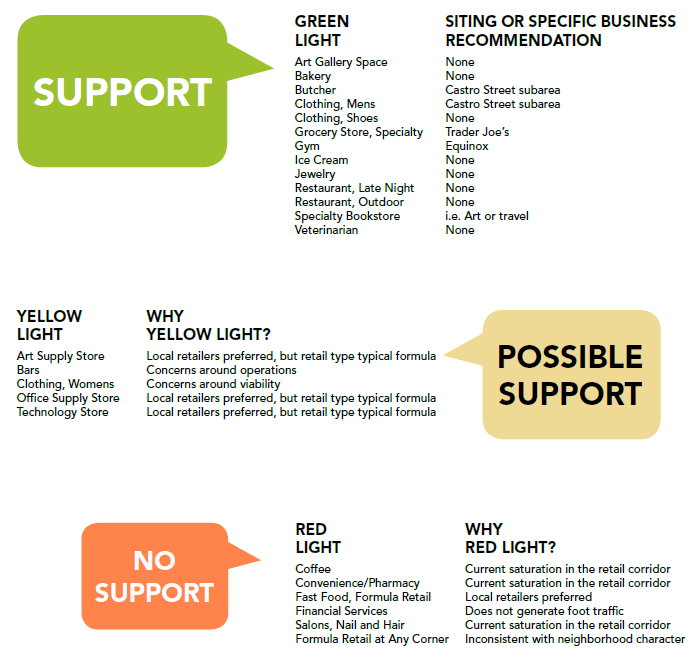
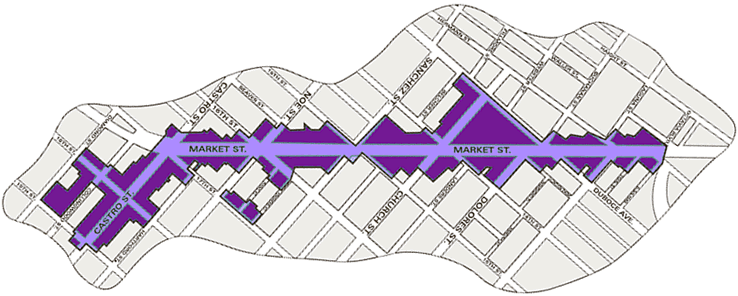

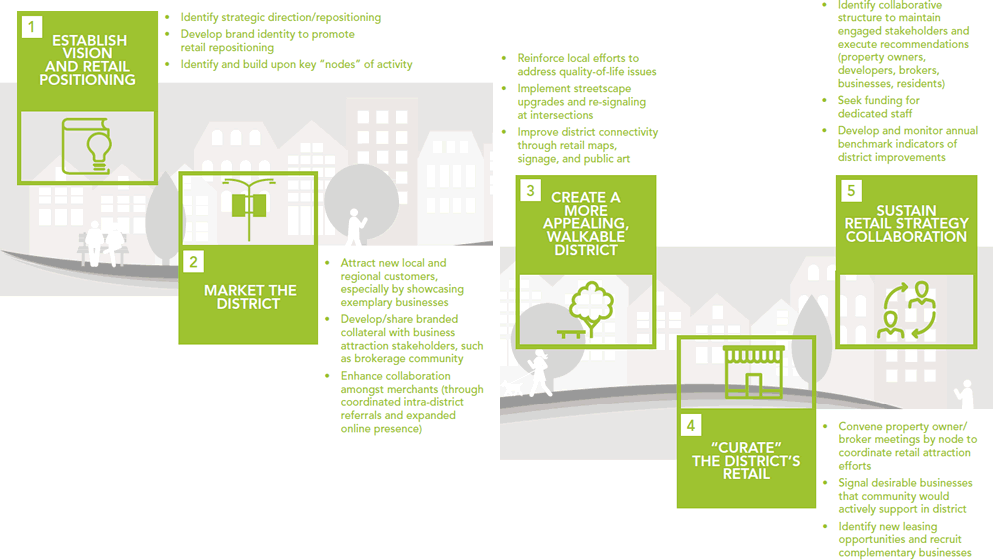
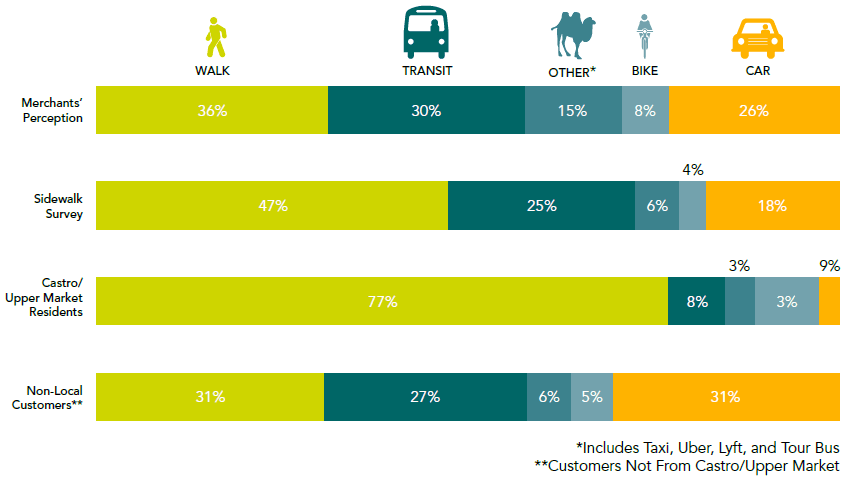
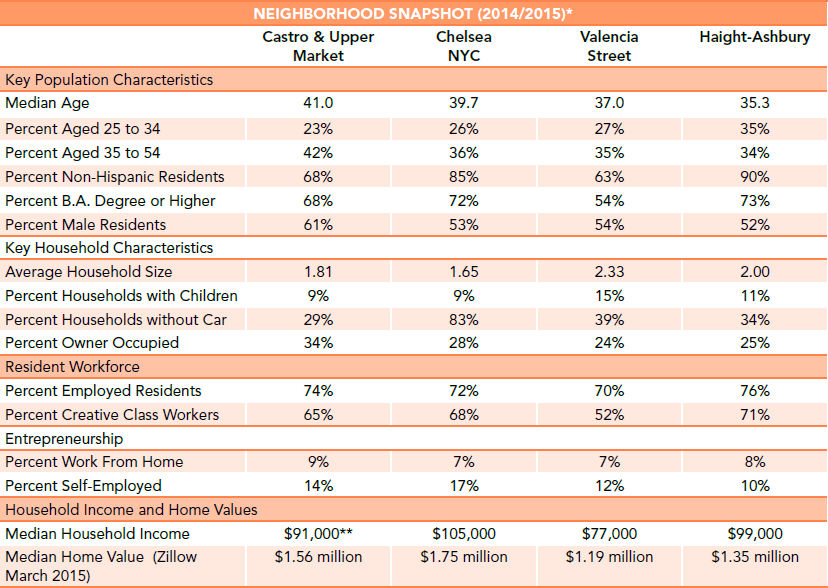
I would give my left kidney for a better gym and a grocery option in between the extremes of Safeway and Whole Foods.
I would give your left kidney too.
Seriously, a Trader Joe’s in the Castro would be so sweet.
This area has a walking score close to 100 and they could make the bold choice of having no parking and still manage to have a great customer base. People who hop by Trader Joe’s back from work can go to the 2 other locations less than 2 miles away. They would even find easier parking with the Castro/Duboce/Lower Haight customers out of the way.
The Trader Joe’s ship has sailed when Radioshack refused to move out of their space on Market and Noe Sts. A little while later and Radioshack declared bankruptcy. There were also concerns by the nearby residents about parking and TJ’s affect on the weekly Farmer’s Market. The truth is between Safeway, Whole Foods, Golden Produce and Harvest Market there is no shortage of locations to patronize for one’s groceries in the area.
Agreed, it’s pretty silly to me that this group has prioritized both a Trader Joe’s and an Equinox. Groceries and gyms are readily available in the Castro and along Market, and I can think of several specialty retail spots that might be better welcomed (like the watch / clock repair place that is being forced out to Sausalito because of rising rents). What about another plant nursery or bike/scooter shop? Vintage furniture shop? Etc.
Watch?
For the few watches left, they can be repaired at Karizma on Church. We have two bike shops, one on Sanchez and another on 17th Street. It is a short walk to the Mission for inexpensive produce, if you want to skip the Castro completely.
Every landlord must think they can get a national chain to pay the high rent. Well, it just is not happening and they need to wake up.
Also, Cliff’s has been dollars cheaper than Walgreen’s on some household items like mothballs and moisture absorber. We are being gouged by some of the national chains. Pick up or look online at Walgreen’s suburb ad. It was inserted by mistake in the weekend Examiner for awhile. It has twice as many pages of discounts which don’t appear on our shelves.
I like the sense of humor displayed by the graphic designer of that mode share chart. Check out the symbol used for “other”.
And once again merchants overestimate the importance of cars to their customers.
They understandably do not want to cut themselves from one of five potential customers.
But what they fail to understand is that making a neighborhood pedestrian-centric attracts more crowds and greatly compensates the loss of drivers.
the scale’s off in that chart, especially the third bar—> 9% by car is somehow smaller than the 3% bike segment. Maybe they got the order wrong, but it doesn’t help to calm down the folks claiming bike advocates are juicing their numbers.
I suspect that’s a .9% and they left off the dot.
If “Other” gets a camel, then “Transit” should be either a snail or turtle.
The City should commission a report to decide which is more appropriate.
You are setting unrealistic expectations if you expect SFMTA to move as rapidly as a snail or a turtle. The banana slug would be a much better representative for our fair City’s transit – its not only a SF native but it is also the slowest mollusk in the world as its average speed is only approximately 0.000023 m/s.
I think we need a ballot proposition…..
I thought that green light art installation along the top of Market Street near Van Ness actually transported people. I was wrong.
ubers and taxis are cars
that are reused by hundreds of people and never parked in the neighborhood
Their favored retail goods categories have all been shifting online. Along with the increased competition from nearby neighborhoods (Mission, Hayes Valley, and Lower Haight/Divis), it’s been a long time since Castro stood out as a shopping destination. How many food and personal services businesses can the immediate population support?
The information on page 50 on the document at the link in the article references the broker focus group. That is much more indicative of the issues resulting in the neighborhood commercial vacancies.
Thanks for the pointer. While I agree with their list (below), those are fairly technical reasons that make it difficult to operate there. My point was more about how the retail landscape in SF has shifted away from the Castro and away from the kinds of stores they are suggesting. For people like myself that don’t live in that neighborhood, Castro was more of a shopping destination 15-20 years ago than now. Everywhere around it from Dogpatch to Nopa has gotten better and more competitive with the retail mix in the Castro, while the Castro seems to have declined. Trips I used to take to the Castro to buy retail have shifted more to the other neighborhoods and online. I doubt there is anything they can do to recover the advantage they had 15+ years ago. The other neighborhoods are too far along and too successful and collectively have more undeveloped potential to leverage than Castro. I suspect most of the growth for retailers in the Castro is from the immediate population.
Given the good transit and central location, maybe a mix of small office spaces, like what helped the area around South Park hum and are getting pushed out of downtown, might give the retailers more daytime business.
________________
Brokers perspectives from the Broker Focus Group:
– Rents are highly varied.
– Many buildings require significant improvement.
– Requests are low compared to nearby districts.
– Retail mix is not strong in many areas.
Businesses concerns:
– Adult stores can be a turnoff to family/larger/image brands.
– The demographic is predominately older gay men.
– “difficult” to get community support.
To pick at nits… “Inactive storefronts are offering refuge to an increasing number of homeless [ ] . . .”
Clearly homeless people (or better yet, people suffering homelessness) are a big issue in the Castro and SF overall, but I don’t think dehumanizing them helps.
Unless of course socketsite was referring to homeless dogs/cats/camels…
How about “vagrants”, “addicts” or “derelicts”?
“homeless” as a noun is an acceptable form. Usually used as “the homeless” but the Editor’s sentence is correct and not offensive or dehumanizing at all.
What is dehumanizing is the way some groups are using the homeless as a fuel to their often unrelated causes. Some will exploit the homeless cause for religious purposes, or to further a leftist agenda, or to encourage class warfare. Marginally, some will make a living from the homeless without solving one real problem (too many people come to SF without the proper skills to survive) and even encouraging more homeless to come from the outside.
I agree that “homeless” is grammatically correct; there are plenty of grammatically correct things civil society refrains to say/print…
Regardless, I agree we could discuss the non-profit industrial complex or whatever the ‘right-ist’ agenda wants to discuss (it’s truly worth discussing). But, we’ll probably not have a civil discussion if our characterizations of people (flaws and all) imply that we don’t care about people from the onset because they are unworthy vagrants, addicts, derelicts, or puppets/pawns of the left. People are people and should be treated like and discussed as such (again, flaws and all).
I did not say “vagrant, addicts, derelicts”.
But are the homeless used for political purposes, definitely. And many advocates will fight tooth and nails against “return to sender” initiatives, because some people became homeless prior to coming to SF and just came to a friendlier city. No-one can blame the homeless to go where the help will be, but a city (read its citizen) should have their say instead of just throwing money to an ever-increasing and mostly imported problem.
last thing I’ll add (I think our points are pretty clear here): people suffering homelessness are often citizens of both the US and the city/state they choose to live who deserve just as much respect and weight of voting in elections as people enjoying housing. I was happy when City Attorney Herrera pushed for compensation from Nevada (cities/states, don’t quite remember) a couple years back, but that doesn’t mean we should punish the people who get pushed around and allegedly have no rights.
You verbally delegitimize people suffering homelessness (regardless of Doug B’s ad hominem attacks) through your assertion that those people have no agency or are non-citizens (as opposed to vets, like the VAST majority of people suffering homelessness in the US, if not those in SF).
Your actions make me want to listen less to your probably-valid points because they are veiled in unnecessarily bombastic rhetoric.
You are grandstanding with little relationship to what I said. I did not say we should punish anyone. If someone gets kicked out because he is trespassing, is this a punishment or the application of the rule of law. The city should have more strict rules about imported homelessness, against people who arbitrage their location based on how much they can get from a community. It’s not punishment, it’s sound policy and a sign of respect to the homegrown homeless whose needs are diluted by this phenomenon.
Also, I did not say they were not citizen. Again, telling someone he is trespassing (the closest word I could find) is not denying that person constitutional rights, it’s the application of rules.
Also, I am pretty straight about my positions. I do what I say and say what I do and do not like to hold back. Posting for 8 years now on SS Not everyone’s a fan.
And some (including editorial boards and their letter writers by the score) make “the homeless” whipping boy for every imaginable ill of the City.
What gain do they bring?
How is that relevant to their and the City’s plight?
I have plenty of friends who won’t come to SF anymore because they are tired of being harassed by enabled junkies and street kids (homeless or not).
Streetlight Records is closing. The Simply Brilliant Press location is for lease. Pottery Barn wants to leave. These are more storefronts to add to the empties. They say we are second to Union Square area in revenue, but the lack of foot traffic and the empty store fronts just do not support that fact. Rents must be based on some fantasy numbers. Someone was blaming the Castro’s ‘demise’ on the resurgence of Valencia Street, but the Castro’s lagging economy has been going on since the last tech crash. That is a long time.
Some businesses are doing better than others, just like other neighborhoods (like North Beach and their moratorium on bars and pubs). And the city is trying to micro-manage what can and what cannot be there, which is laudable (we all want diversity in stores) and laughable (businesses that do not have a customer base cannot stay, no matter how many permits and easements you provide them).
Now, one issue with the Duboce side and Pottery Barn is that very few pedestrians will cross Market from Castro street, favoring the more human-friendly Noe street. If Pottery Barn were to be replaced one day with a Trader Joe’s, this would change everything and create more foot traffic.
Streetlight is having a great sale, for those who still buy CDs (OK, just me.). Picked up a bunch for $2.99 each last week.
I actually quite like this corridor (again, just me) with soon RIP Streetlight, ROLO etc. And often hit the Duboce farmers on Wednesdays.
A friend made me CDs of her preferred music last month. This was an awkward moment as I realized I do not own a CD player anymore.
The Pottery Barn situation is a Williams-Sonoma Inc. corporate decision. The company just isn’t doing well in many locations (W-S closed 2 of their 4 SF locations in the past two years).
Foot traffic does seem to be down. Last Friday evening (6-9pm) the area was dead.
So let me see, if I can just figure out how to make a mens clothing and shoe store with a gym inside, and also have a grocery section with both an artisanal baker who also makes ice cream on the side and a butcher who also happens to be a veterinarian, plus have a late-night restaurant in the (miniscule) yard out back which of course has art hanging on the walls of the outdoor bakery oven, then i’m guaranteed to get approved right?
Meanwhile, why does West Hollywood seem to be more popular than ever, or Boystown in Chicago for that matter? In West Hollywood, check out the portions of Melrose, Robertson and Santa Monica Boulevard, especially the area comparable to our Castro and see the transformation for yourself. In the last 20 years West Hollywood has had the opposite story compared to the Castro, and you now have some of the most expensive shops and restaurants in the Los Angeles area locating in West Hollywood instead of Beverly Hills, with very little chain stores, and a lot of creative independent boutiques and cafes.
I ask my self the same question every time I am in WeHo. How come this is so attractive and vibrant and the Castro … well … isn’t?
Can someone explain how the neighborhood can be clamoring for a Trader Joes but also be against formula retail? Isn’t Home Depot:Cliffs asTrader Joes:Buffalo Market or Chipotle:Cove and so on.
Because buying the same stuff at a 60% premium only works in grocery stores where you HAVE TO be seen like Bi-Rite (ok, ok, they do have some nice cold cuts). I go to Cliff’s when the extra 10 minutes to ACE is not worth the difference. But I will not do my bulk shopping at Buffalo WF&G. This is the reality for the mere humans.
Because Trader Joe’s wasn’t PC enough for the DTNA
how did they determine if a store type has reached “saturation”? if a tenant wants to operate a coffee store and is able to stay in business, then isn’t it by definition not saturated?
And with Jumpin Java and Cafe Sophie (temporarily) closed, coffee is no longer saturated.
How about green-lighting “Restaurant, Non-mediocre”?
Yes!
Precisely.
They need a study to figure this out? Is this their first time at the rodeo?
I walk this area and shake my head at all the missed business opportunities because of over-regulation and every one needs a say in what is considered worthy of the area. I’ll take a Chipotle any day over blighted filthy street, but of course it may ruin the character of the area–because we all know the gutter “rats” add so much to the area.
I think San Francisco is the only city in the world where occupied store fronts and employment are a bad if the business doesn’t conform to some governing body. So much for the city that is open to everyone–everything.
The neighborhood feels past its prime. It feels like it continues to be shaped by old timers who have no idea what younger people gay or straight want. To young gay men (and gay men have driven the area for decades) its a place to have a cocktail in a bar with a mixed crowd. To see the area feel alive again allow new bars to open. I know that may not be popular with the baby stroller set who have settled recently. But honestly what other concept would work?
Agree, I was surprised to see new bars under “yellow light” – as a resident of the Inner Richmond, when we go to the Castro it’s to meet friends (bar and/or restaurant), with some ancillary window shopping (general clothes) thrown in on the side.
Also, I take umbrage at the dig at the adult shops – frankly I’ve always found them in a bit poor taste myself, but they were there (and thriving, and in a thriving neighborhood overall) long before Pottery Barn and SoulCycle came along. If the yuppies with their baby strollers are offended by the sex shops, then let the yuppies go elsewhere!
So let’s pause and reflect on neighborhood plans: Mission (North Eastern Neighborhoods Plan) 10 years in the conjuring with a witches cauldron of busy bees and the result? Ugly million dollar condos, a Kardashian Class of bottle service loving bad shoe wearing trolls, fume belching disrupting cesspools with names like Munch-it or whatever… or the McChopin Stub (think amputated limb) with its rad skate park and mini-park of horrors. So what now, San Franciscan’t? Can it get any worse? Well if there is a chance, put the Weiner and his minions on the march and sure enough we’ll pretty soon be having “Birth of a Nation” reruns with complimentary rebel flags running at the Castro Theater.
Uncle Mame deserves an immediate green light.
The sampling is problematic. While 1200 “customers” may be a sufficient size for the population of 32,000, the sample is poorly defined and apparently not random. The results may not be valid.
Surveying 450 persons on the street, which included a Saturday at 6-8 pm in the Castro or at the Castro Street Fair will obviously skew results. This may account for the surprising results of how customers “get there,” for example.
The online respondents are not random either. Volunteer respondents do not produce a random sample. So what have we learned? We learned that those surveyed, which doesn’t appear to represent the population, have expressed their opinion.
I agree with your comment, but the idea of a flawed sampling leads me to wonder why? Do you think it was just a simple poor design decision? Insufficient funds? Hidden agenda? Something else? The lead for the project, Danny Yadegar has a Master’s Degree in Urban Planning from MIT. There were consultants on the team as well. All that knowledge, yet we get a problematic sampling.
Don’t assume that the urban planners have all the answers, even with their PhDs. They were most likely responsible for Jane Warner Plaza, and we know how that is turning out. Urban planners love to create lovely graphics copied and pasted from the Sesame Street handbook. Let successful businesses drive what’s best for the neighborhood, instead of trying to overthink and socially engineer (San Francisco’s favorite pastime). I agree with the West Hollywood comment. Find out how they achieved success and just do that, instead of wasting money on consultants.
SFCitizen, I do not know why and wonder as do you. When I brought my concern to the attention of those in charge of the project before the street surveying was to occur, the response I got was, “Do you want do some surveying then?”
West Hollywood/Castro? No basis for a comparison other than they’re both populated by a lot of gay men. One’s a city with a wide range of businesses competing aggressively to make and keep itself at the top of the heap; one’s a neighborhood full of neighborhood shops whose primary recent achievements have been in memorializing its past and pretending that’s enough. One’s surrounded on a couple of sides by extremely wealthy places with significant commercial and residential development constraints, one’s surrounded by relatively similar neighborhoods with relatively similar rulebooks. One is San Francisco, a noun, which is terrified of change, and one is Los Angeles, a verb, which gleefully tears itself down and builds new when the mood strikes. Look at this.
I counted 500 housing units, 445 hotel rooms, and 50,000sf commercial space before I got bored, and I was only clicking projects under construction or already approved. West Hollywood is developing because it’s thriving, yes. But it’s also thriving because it’s developing. You want new life, you gotta make room for it.
I thought about our Castro (and Don’s comment) during a lunch at Petrossian in West Hollywood I was invited to. Petrossian’s expensive caviars, pate, foie gras and cheeses were being devoured by young hip customers with every table full and many standing waiting in line, and I could not help but feel astonished that such a cafe would work in West Hollywood, but would never survive in the Castro.
The other thing that astonished me about West Hollywood was the amount of pedestrian traffic, which seemed far busier than our Castro. As mentioned above “One’s a city aggressively trying to make and keep itself at the top of the heap; one’s a neighborhood full of neighborhood shops whose primary recent achievements have been in memorializing its past”. I thought of this post and article while I was down there and wanted to write that Don’s comment is spot on!
Speaking of retail and (soon to be) vacancies on Market Street: Price Slashed For Streetlight Records Building, Owner Cashing Out.